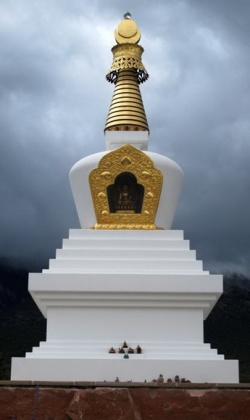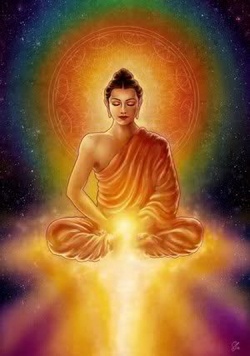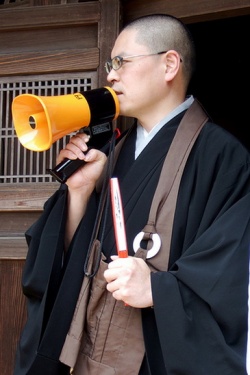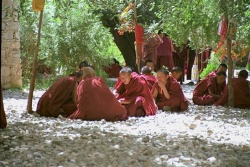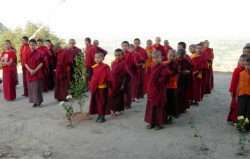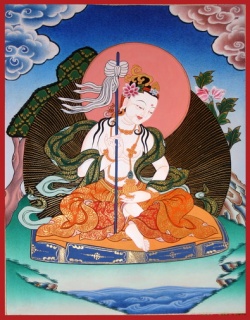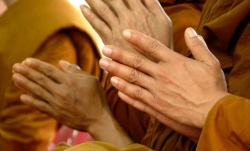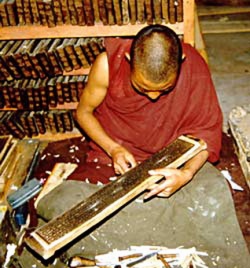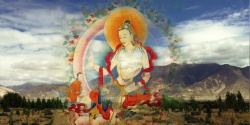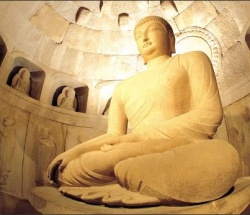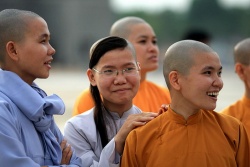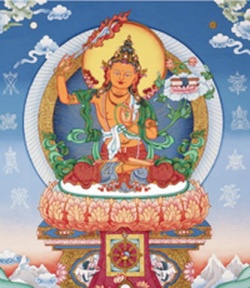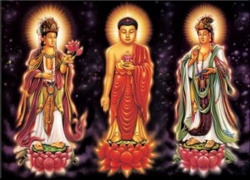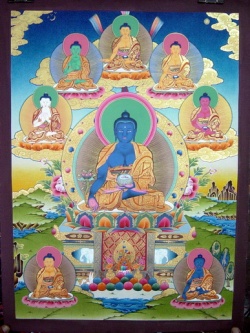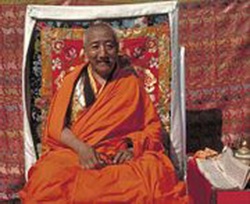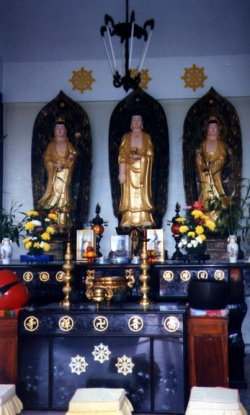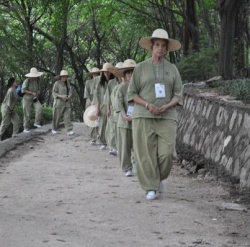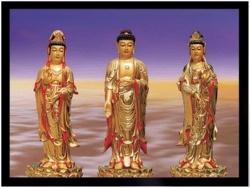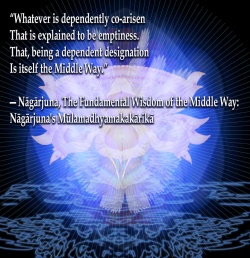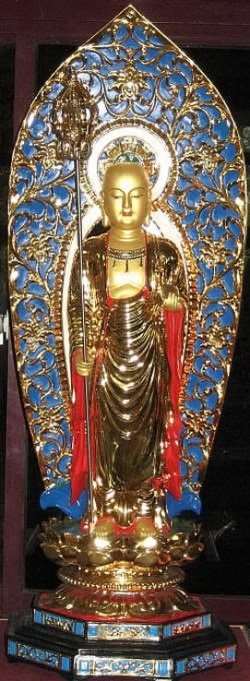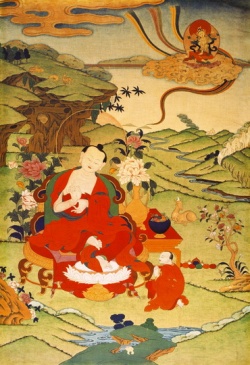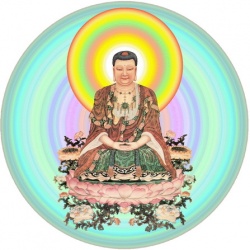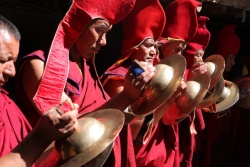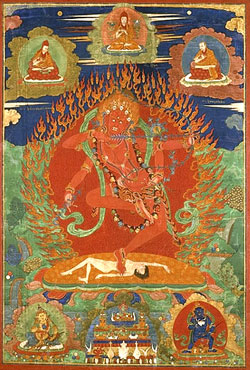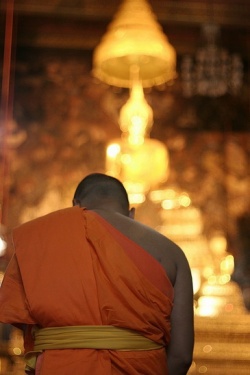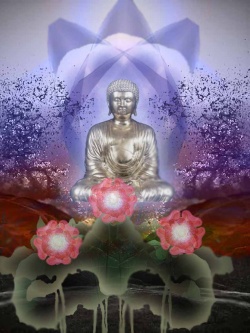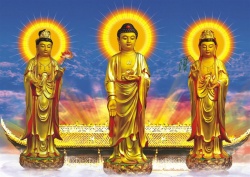A critical discussion of Buddhaghosa’s Account of the Origin of the Theravada Abhidhamma
A Critical Discussion of Buddhaghosa’s Account of the Origin of the Theravada Abhidhamma
01.Introduction
In Theravada, Mahayana, and other Buddhist schools have separate text called Abhidhamma. Until today many Theravada scholars try to prove that Ahdhamma was preached by Buddha. Mainly the great commentator Buddhaghosha thera who livd in 5th century BC emphasizes in his commentaries such Atthasalini, as Abhidhamma text was preached by Buddha. Some scholars say it was not preached by Buddha because in different Buddhist schools the texts such as Sutta and Vinaya pitaka satisfactorily similar but Ahidhamma Pitakas among various Buddhist schools completely difference.
In Theravada tradition abhidhamma accepts with great esteem.
In Sri Lanka in 10th century AD king Kassapa V inscribed all abhidhamma texts in gold plates and decorated Dhammasangini which was the first book of the Abhidhamma, and the cover made using the gems. In eleventh century king Vijayabhahu used to study abhidhamma text book Dhammasangini every morning before start his duties. Because of esteem immense acceptance Theravada tradition mentioned seriously in commentaries that the genesis of Abhidhamma pitaka happen from Buddha.
Both sarvastivada and Theravada mention that the Abhidhamma taught by Buddha himself.
According to Abhidhammakosavyakya which was wrote by Vasubandhu mention that the Buddha himself has taught the the Abhidhamma.
“evam abhidharmo hi dharma-laksanopadesasvarupo vineyavasat tatra bhagavatoktah”
Atthasalini says fist Abhidhammika is Lord Buddha and he himself taught the seven books of Abhidhamma.
“Sammasambuddho va patamataram Ābhidhammiko”
Sarvastivadin and Theravadin both have complete abhidhamma texts. Other Buddhist schools do not have complete abhidhamma texts. Sarvastiada Abhidhamma texts were written in Sanskrit language. Later as a result of foreign invention Sanskrit scriptures destroyed. Before destruction of the Sarvastivada Tripitaka, a Chinese translation of all texts has been brought to China. Theravadin have complete Abhidhamma texts in original. They used Pali language to write their texts. Both tradition have seven books as Abhidhamma texts. The important thing is those seven texts are different in the two schools. Sutta and vinaya texts are similar in their core parts. Although in Abhidhamma content is different to each other. The seven texts of Abhidhamma pitakas of both traditions are as follows.
Theravada Abhidhamma texts,
01. Dhammasangani (Enumeration of Factors) - Describes the fundamental phenomena which constitute human experience.
02. Vibhanga (Analysis) - An analysis of various topics by a variety of methods, including catechism, using material from the Dhammasangani.
03. Dhatukatha (Discussion of Elements) - Some interrelations between various items from the first two books, formulated as sets of questions and answers.
04. Puggalapannatti (Descriptions of Individuals) - An enumeration of the qualities of certain different personality types. These types were believed to be useful in formulating teachings to which an individual would respond positively.
05. Kathavatthu (Points of Controversy) - A collection of debates on points of doctrine, traditionally said to have been compiled by Moggaliputta Tissa at the Buddhist Council sponsored by King Ashoka, which took place in the 3rd century, BCE.
06. Yamaka (The Pairs) - Deals with various questions relating to interrelations within various lists of items; here the items belong to the same list, whereas in the Dhātukathā they are in different lists.
07. Patthana (Foundational Conditions or Relations) - The laws of interaction by which the dhammas described in the Dhammasangani operate.[1]
Mahayana Abhidhamma texts,
01. The Sangitiparyaya, - Chinese, Sāriputra, Sanskrit and Tibet Mahākausthila
02. The DharmasKandha - Chinese, Maudgalyāna, Sanskrit and Tibet Sāriputra
03. The Prajñapti - Chinese, Kātyāyana, Sanskrit and Tibet Maudgalyāna
04. The Vijñānakāya - Chinese, Sanskrit and Tibet, Devasarman
05. The Dhathukathā - Chinese, Vasumitra, Sanskrit and Tibet Pūrna
06. The Prakarana - Chinese, Sanskrit and Tibet Vasumitra
07. The Jñāprasthāna - Chinese, Sanskrit and Tibet Kātyāyaniputra
Another thing is in Sutta and vinaya where mentioned about Buddha’s teaching did not mention the about three pitakas. The word “pitaka” use only in Kalama sutta.
“mā pitaka sampadanena”
According to texts we can see origination of Abhidhamma happened due to the explanation and classification of deep dhamma concepts which were in the Suttas. gradually those interpretation developed and have collected immense classification which can not put with the dhamma as one pitaka. Then it was consider as separate pitaka. Until 3rd century BC developed and with the Kathavattuppakarana which was written by Moggaliputta Tissa Abhidhamma was completed. In Sri Lanka until 13th century AD Abhidhamma texts developed. Today in some countries such Burma still develops Ahidhamma texts.
02. Account of the Origin of Abhidhamma
Buddhaghosa thera in Nidana katha of Atthasalini the commentary on Dhammasangini pakarana tries to prove that the whole Abhidhamma originated from the Buddha. According to Theravada tradition Abhidhamma originated immediately after Buddha’s enlightenment. Buddha spends seven weeks near bodhi tree after enlightenment and in his fourth week he stay in the gem house and memorized the Abhidhamma.
He mentions in Atthasalini in which occasion Buddha taught the Abhidhamma. In seventh vassa session Buddha ascended to Tusita heaven with showing twin miracle and seated in pandukambala which made from stone and under the Paricchattaka tree. Then three months of rainy session he preached Abhidhamma to his mother and devas assembled from ten thousand world systems. Commentary explains that what are reasons to selecting devas to preach Abhidhamma without human. Because the Abhidhamma preaching must do continually from the beginning to end to the same audience. To full preaching Abhidhamma require three months and in human world no occasion for that.
In Nidana kata explains how the Buddha preached three month continuously with sustaining his body. When he want to go pindapata he creates another Buddha and determine this image Buddha must preach in such and such way. Then Buddha goes for alms in Uttarakuru with Sariputta thera and five hundred other monks and went to shore of the Anotatta Lake. Buddha preached dhamma which he preached in deva world to those five hundred monks leaded by Sariputta. Sariputta thera taught it to his disciples. Parivarapali, vinaya text book provide evidence for this, but this text book is late addition. But this kind of report not include in any sutta.
03. Abhidhamma contemporary to the load Buddha
Whole dhamma of the Buddha has categorized in to three parts. Those are called Tripitaka, or Tipitaka.
1. Vinaya piṭaka
2. Sutta pitaka
3. Abhidhamma pitaka
These each pitakas have its own characteristics. To identify differences among these three and its characteristics, definitions of commentaries are very important.
The word vinaya derived like this,
vi+naya,
the prefix “vi” give the meaning of especial, the word “naya” means precepts which were enacted by Buddha such Patimokkha, uddessa, parajika etc. Usual meaning of the word Vinaya is discipline. In Vinaya pitaka commentary “Samantapasadika” says,
“vividhavisesa nayata - vinayanato ceva kayavācānam
Vinayattha vidhūhi - vinayo vinayoti akkhato
“Because there include various especial precepts and discipline the body and word, expert on vinaya named vinaya as “vinaya”. According Parajika pali Lord Buddha proclaims ten purposes of enacting vinaya. According to that purpose of vinaya not only discipline of body and word, but also survive of Buddhism and progress of the sangha community.
Second pitaka is sutta pitaka. The commentary Samantapasadika define sutta pitaka like this,
“Atthānam sūcanato, suvuttato ca savanato ca sudanato ca, suttānā suttasabhāgato ca, suttam suttanti akkhātam”
Because of denote the meaning well, promulgate the meaning well, can listen well, and use as a thread to collect various suttas in to one line, therefore suttas named as sutta.
Third and most important pitaka in this work is Abhidhamma pitaka. After the Lord Buddha’s extinction gradually originated various schools in the Sangha community. These all schools had tripitaka and their own Abhidhamma Pitaka. But only Sarvastivadin and Theravadins had complete Abhidhamma pitaka. Today remains only Chinese and Tibetan translation of Sarvastivadin’s Abhidhamma Pitaka and original Sanskrit Abhdhama pitaka cannot find. Theravada has their own original pali Abhidhamma texts completely.[2]
The word Abhidhamma has derived from
“abhi+dhamma”
“abhi” is a prefix and “dhamma” is a noun.
The prefix “abhi” convey the meaning of extra, super, more, especial etc.
So the word Abhidhamma uses for introduce very important special dhamma among other two pitakas.
The term “Abhidhamma” means supplementary dhamma and special dhamma. Sinhala encyclopedia explains about word abhidhamma as, among sutta and vinaya dhamma chose especial facts compile in Abhidhamma.
Further it says the greatest event in Buddhist philosophy is Abhidhamma which developed both Theravada and Mahayana tradition.[3]
The commentary Samantapāsādikā define Abhidhamma like this,
“yam uttam uddhimanto - salakkhanā pūjitā paricchinnā
Uttādhikā ca dhammā - abhidhammo tena akkhāto”
“If something improves, has its own characteristics, was offered by others, especially, superbly, and uncommonly promulgated, that is named as Adhidhamma.”
The Great commentator Buddhaghosa thera gives various meaning to the word Abhidhamma. In Sumangalavilasini, Dighanikaya commentary, where analyze the Sangiti sutta gives two different meaning to the word Abhidhamma.
“Abhidhammoti sattappakaranani”
Abhidhamma is seven books of Abhidhamma pitaka. “maggaphalani Abhidhammo” Abhidhamma is fruits of the monk hood. In the Kinti Sutta of Majjhima nikaya says Abhidhamma is seven facts of enlightenment. In the Anguttara Nikaya says Abhidhamma is noble speeches.[4]
In Sumagalavilasini Dīga Nikāya commentary and other commentary refer tripitkas but in sutta and vinaya pitaka texts refer only about two pitakas. In Sumangalavilasini mention about abhidhamma means like this,
“Dhammasamgini vibhamgañca - kathāvatthu ca puggalam
Dhātu yamaka patthānam - abhidhammoca uccati”
“evam sańvaņņitam sukhumaŋāna gocara tanatim sangayitvā idam abhihamma pitakam nāmāti vatvā panca arahanta satāni sajjhāyamakańsu"[5]
Seven books such dhammasangini, vibanga, kathavatthu, puggala paññatti, dhatu, yamaka, patthāna are name as abhidhamma.
In Dhiganikaya tika explain that Abhidhamma is the dhamma which is superfluous, excellence and include in seven books of abhidhamma pitaka. [6]
“abhidhammoti sattappakaranani adhiko abhivisittho ca pariyattidhammoti katva….”
Atthasālini says,
“kenatthena abhidhammo? Dhmmatireka dhamma visesatthena athireka visesatthadipanako hi ettha abhidhammo”
Here the word abhi for convey the meaning of extra and especial, so abhidhmma mean extra or especial dhamma.[7]
Vasubandu in his Sanskrit book Abhidhammakosa says, “Abhidhamma is the undefiled and it concomitant”.
Asanga’s interpret Abhidhamma in four ways,
the dhamma which is encountering Nibbana,
the dhamma which is analytical,
the dhamma which is devoid of the converse views, and
the dhamma which is progressive.
Abhidhamma has characteristics such
“rasa” fuction,
“paccupattana” manifestation,
“padatthan” proximate cause.
Collection of the meanings to the word Abhidhamma gives kogen Mizuno according to various traditions.
The Chinese tradition gives meanings like great doctrine “ta-fa”, peerless dhamma “wu-pi-fa”, facing dhamma “tuei-fa”, proceeding dhamma “hsiang-fa” , and excellent doctrine “sheng-fa”.
Bhatanta opinion is which is accumulating and arrange the defilements, the purification, existence, and nibbana it is the Abhidhamma.
According to the Ghosaka opinion abhidhamma is which gives clear understanding about four noble truth and nibbana to the person who seek the nibbana based on right practice. Mahinsasika opinion is its wisdom lights the all worldly doctrine therefore it name as Abhidhamma. Buddhadeva’s opinion is prefix “abhi” gives meaning of main. There for Abhidhamma means main doctrine.[8]
Atthasālinĩ, the commentary of Dhammasangini, emphasizes the distinctions among dhamma and Abhidhamma. Suttas are belongs to discursive style “Sappariyāya desanā” which use simile, metaphor and the anecdotes. Abhidhamma is belongs to non-discursive style “nippariyāya desanā” which use impersonal, terminology meaning and functions. In another place of this commentary show distinction among Dhamma and Abhidhamma using these terms in same meanings. “Suttanta pariyaya” and “Abhidhamma pariyaya” further Atthasālinĩ says,
“Ettha hi Vinayapitakam anarahenna bhagavata anabahullato desitatta anadesana, Suttanta pitakam voraharakusalena bhagavata vohara bahulato desitatta voharadesana, Abhidhammapitam paramatthakusalena bhagavata paramattabahulato desitatta paramattha desana ti vuccati”
Vinaya pitaka is the discourses on injunctions (ānā desanā), Sutta Pitaka is the popular discourses (Vohāra desanā), Abhidhamma is the discourses on ultimate truths (Paramattha desanā). According to Atthasālinĩ the term Ābhidhammika use for who skilled in Abhidhamma.
The term Abhidhamma find in sutta and vinaya pitaka before completing the third Abhidhamma pitaka. In Mahaparinibbana Sutta Buddha says after my extinction dhamma and vinaya will be your teacher. Here explain only about dhamma and vinaya but not include Abhidhamma.
“yo kho Ānanda mayā dhammoca vinayoca desito paññatto so co mamaccayenasattha”
In Mahaparinibbana Sutta Buddha explains how new concepts can include in to dhamma that new idea must consider according to dhamma and vinaya.
“suttevā otaretabbā vinayevā saneda sesatabbā”
In these very significant places can not see the word abhidhamma. The word abhidhamma they did not consider like dhamma and vinaya but they used it to explain various Buddhist concepts.
In Kinti sutta of Majjhima nikaya found the word Abhidhamma and it means seven facts of enlightenment.
“tattha siyum deva bhikkhu abhidhamma nā nā vādā”[9]
In Gulissani sutta when explain what kind of things forest monk must do used word Abhidhamma.
“Araññakena Bhikkhu nā abhidhamme abhivinaye yo go karaniyo”[10]
Contemporary to the lord Buddha the word abhidhamma has used but not for seven books of abhidhamma. In Mahagosingha sutta of Majjhima nikaya says,
“idhāvuso sāriputta dve bhikkhu abhidhammakatham kathenti. Te aññamaññam pañham pucchanti”[11]
sariputta, here two monks discuss on dhamma with ask question each others. Dhamma discussion and questioning each other at that time named as abhidhamma.
In Natakarana Sutta of Anguttara nikaya, when explain relieve facts to existence,
“Abhidhamme abhivinaye udarapāmojjo hoti”[12]
In Anguttra nikaya, when explains qualities of a thera,
“Abhidhamme abhivinaye udarakāmova” [13]
In Mahavaggapali, when explains ability of a teacher who teach to monks,
“patibalo hoti Abhidhamme vinetum abhivinaye vinetum” [14]
the term Abhivinaya same with the word Abhidhamma which come in Vinaya Pitaka, it declare that the monks who is not capable instructing on Abhidhamma or Abhivinaya must not ordinate any disciples.
The term Abhidhamma not use only with Abhidhamma in the Anagata baya Sutta of Anguttara nikaya says, “a talk pertaining to teaching (dhamma), a talk pertaining to questioning…
“Abhidhamma katham vedallakatham….”
There for scholars suppose origination and development of Abhidhamma occur in sutta pitaka.
Buddhagosha Thera in Atthasalini further emphasize that Abhidhamma was preached by Buddha with saying thus,
“iti satthāra dinna nayena thapita mātikāya desitattā sakalampi etam pakaranam Buddha bhāsita meva jātam”[15]
When Buddhaghosa thera explain about Katavatthuppakarana which was wrote by Moggaliputtatissa thera after 218 years after the Lord Buddha’s parinibbana.
Further he says,
“I will set forth, rejoicing in what I reveal, the explanation of the meaning of that Abhidhamma as it was chanted forth by Maha Kassapa and the rest, and re-chanted later by the Arahats, and by Mahinda brought to this wondrous isle and turned into the language of the dwellers therein. Eejecting now the tongue of the men of Tambapanni and turning it into that pure tongue which harmonizes with the texts showing the opinion of the dwellers in the Great Minster, undefiled by and unmixed with the views of the sects, and adducing also what ought to be adduced from the Nikayas and the Commentaries.”
In Atthasalini Buddhaghosa says,
“Abhidhammassa nidana kiccam nāma natthi paņditati”[16]
“wise, no nidana story to Abhidhamma”. But Buddhagosha thera gives Nidana story of the Abhidhamma Pitaka in Atthasalini commentary.
According to Atthasalini some monks challenged to Abhidhamma and said Suttas are the real teaching of the Buddha and Abhidhamma is not said by Buddha. Atthasalini refer this narrative,
A Bhikkhu seated where dhamma preached and asked, “preacher you quote a long text as though you were going to encircle mount Sineru. What rext is it?
“Abhidhamma texts brother”
“Why do you quote the Abhidhamma text? Does it not behave you to quote other text spoken by the Budhha?”
“Brother by whom was the Abhidhamma taught?”
“Not by Buddha”
“But did you brother, study the vinaya pitaka”
“No brother, I did not”
“Methinks, because you have not studied the vinaya pitaka, you say so in ignorance… for, it has been said by the Buddha, “if without any intention of reviling the Vinaya one were to instigate another, saying ‘pray study the suttas or the Gathas or the Abhidhamma first, and afterwards you will learn the Vinaya’, there is no offense in him”
“Anapatti na vivannetukāmo ingha tāva āvuso suttantam vā Gāthāyo vā Abhidhammam vā pariyāpunassu, pacchā pi Vinayam pariyapunissantiti”
“if she question on the Abhidhamma or Vinaya after getting permission to question on the Suttanta, or on suttanta or vinaya after getting permission to question an the Abhidhamma…but you do not know even that much...”
“Suttante Okasam Kārāpetvā Abidhammam vā vinayam vā ayam pucchanti..”
“The Mahagosingha Sutta is even a stronger authority… ‘brother Sāriputta, in the religion the talk of two bhikkus on the Abhidhmma, each asking and answering the other without faltering, is in accord with the Dhamma…
”
“Idhāvuso Sāriputta dve bhikkū Abhidhamma katham kathenti, te aññamaññam pañham pucchanti..”
This report proves that there were divisions of monks who not believe Abidhamma was not taught by Buddha. Here quote the Mavavagga and 95th pācittiya of Bhikkhuni vibanga of sutta vibanga.
When enquire about Abhidhamma reports of councils are very important. In the pañcastikakhanda of cullavagga, of vinaya pitaka report briefly about the first council. Mahakasspa thera was chief of the order addressed the monks assembled at Rājagaha like this,
“handa mayam āvuso dhammañca vinayañca sangāyeyyāma. Pure abhammo dippati, dhammo patibāhīyati, avinayo dippati vinayo patibāhiyati”
According to 1st council’s report there they only recited dhamma and Vinaya. Firstly vinaya pitaka was recited by Upali thera and vinaya pitaka recited by Ananda thera. No one recited Abhidhamma pitaka. Nidana kata of Atthasalini the commentary of Dhammasangini says Abhidhmma consists in dhamma and Ananda thera recited seven books of Abhidhamma pitaka with sutta pitaka.
In Atthasalini refer about Kuddhaka nikaya; “what is Khuddhaka nikaya, the whole of vinaya pitaka, abhidhamma pitaka, and fifteen books….”
“Katamo Khuddhakanikayo? Sakalam vinayapitakam abhidhamma pitakam Khuddhaka Pāthādayo ca pubbe niddessita pañcadasabhedā, thapetvā cattāro nikāye avasesam Buddha vacananti”
Its says, “according to pitaka, Abhidhamma forms a pitaka of its own but according to nikaya it is included in the Kuddhaka nikaya”
“ayam Abhidhammo pitakato Abhidhamma pitakam, nikayato Khuddhaka nikayam”
In sattasatikakhandaka of Cullavagga pali refer about second council. It was held in Vesali one hundred years after the Buddha’s extinction. 700 Arahants participated for that. In that report do not mention about reciting sutta and abhidhamma. Third council held at pataliputra after 218 years of the Buddha’s extinction.
Moggaliputta tissa thera was precedent of that council. Katavatthu fifth book of abhidhamma pitaka was wrote by moggaliputta tissa thera. Pañcapakanatthakata says because of patronage of the emperor Asoka many teachers and adherents of other faith entered to Buddhist order and continuously they followed their religious practices. The purpose of writing katavatthu is refuting wrong views those other faith bring in to the Buddha dhamma.
Third council held in 253 BC. Yamaka may have written after third council. In Yamaka does not say any new thing but explains technical terms frequently used in Abhidhamma. Patthana also may have written after third council. According to content of Patthana clear that it tries to explain the cardinal philosophy of paccaya relation which comes in Kathavattu. But Milindapanha which belong to 100BC refer about seven books of Abhidhamma. Some scholars says Abhidhamma trexts books completed with 3rd council.
In commentaries commentators name Abhidhamma as third pitaka. Not only that commentators tries to prove that in 1st council Abhidhamma pitakka also was recited by Bhikkhus. In Dīga nikaya commentary Sumangala vilasini says,
“evam samvannitam sukhumajñā gocaram tanatim sangāyitvā idam abhidhamma pitakam nāmāti arahanta satāni sajjhāyamakamsu”
According to sumangalavilasini seven books of abhidhamma texts was preached by Lord Buddha. In the Atthasālini commentary was mentioned by Buddhaghosa thera that Kathavatthuppakarana which belongs to Abhidhamma texts was wrote by Moggaliputtaissa thera after 218 years from the Buddha’s extinction. But commentary says kathavatthuppakarana also he wrote according Mathikas which was given by Buddha. There fore it also can consider as preached by Buddha. Further commentary explains in fourth week after enlightenment Buddha contemplated seven abhidhamma texts in jewel house.
In nidanakata of commentary atthasalini of Dhammasangini gives these answers to these questions about abhidhamma.
01. From which source has this Abhidhamma originated? Faith (saddha), which urges to enlightenment, was the source.
02. Where has it matured? In the five hundred and fifty Jātakās
03. Where it mastered? At the foot of the Bodhi tree.
04. When it mastered? On the full moon day of Vesaka.
05. By whom it mastered? By the omniscient Buddha.
06. Where it studied? At the foot of the bodhi tree.
07. When it studied? During the seven days spent at the jewel house.
08. By whom was it studied? By the omniscient Buddha.
09. Where it taught? Among the Tavatimsa gods.
10. For whose benefit it studied? Of the gods
11. For what purpose was it taught? For release from the four floods.
12. By whom was it accepted? By gods
13. Who are learning it? The Sekkhas the Kalyāna putthujjanas.
14. Who have learned it? Saints free from the intoxicants.
15. Who know it by heart? Those who lay at the heart.
16. Whose word is it? Of the blessed arhat, the Buddha supreme.
17. By whom has it been handed down? By the unbroken lines of teachers.
The unbroken teachers until third council Sariputta thera, Bhaddhaji thera, Sobhita thera, PIyajāli thera, Piyapāla thera, Piyadassi thera, Kasiyaputta thera, Siggava thera, Sandeha thera, Moggaliputta thera, Visudatta thera, Dhammiya thera, Dāsika thera, Sonaka thera, Revatha thera, etc. until today this line comes without stop.
Mahasangika School and other many schools not consider Abhidhamma as canonical text. Some schools include Kuddhaka Nikaya in Abhidhamma. Pali version of Abhidhamma text is work of Theravada monks. sarvastivadin also has Abhidhamma pitaka but it unlike with Theravada Abhidhamma.
To identify real existence of Abhidhamma above suttas are very important.
04. Abhidhamma concept in Primitive primitive Buddhism
According to Kogen Mizuno Abhidhamma Abhidhamma has three stages,
01. Primitive Buddhist era
02. Completing texts book
03. Writing commentaries and sub-commentaries
In primitive Buddhist era Abhidhamma concepts was in the suttas and it developed in sutta pitaka. Gradually Abhidhamma texts were huge and cannot include in dhamma then it separate as deferent pitaka. In 5th century, after 1000 years from the Buddha’s extinction Buddhaghosa thera wrote commentaries for Abhidhamma texts and during 10-12 centuries completed sub-commentaries and sub-subcommentaries.
According to these pali sutta’s phrases it is clear here word Abhidhamma not used for Abhidhamma pitaka. In sutta pitaka find analytical system which similar to Abhidhamma and that can categorize in to three groups,
01. The systematic exposition of the conditions
02. Numerical order of technical terms
03. Detailed expositions
The systematic exposition is the condition producing the desires and virtues, and discussion of the general doctrine. Bahudhatuka sutta and chacahkka sutta of Majjhima Nikaya can include in to this category. In Bahudhathuka Sutta expounding the eighteen dhatu, the twelve senses and objects, twelve links of paticcasamuppada. In chachakka Sutta expose the six sense organs, the six sense objects, the six sense kinds of craving, cause of generating desire and extinction.
In Maha vedalla sutta of Anguttara nikaya mention Mahakotthita thera asked the question and Sariputta thera gave the answers, question like, diference between wisdom and ignorance, with consciousness, sensation, perception, right view, the three states of existence, the four stages of meditation, attaining of annihilation and three forms of emancipation. In cullavedalla sutta of Anguttara Nikaya, Dhammadinna theri, answers the Vishaka on five aggregates, noble eightfold path, difference between condition and unconditioned, annihilation and nibbana.
Arrange dhammas in numerical order, Sangiti Sutta and Dasuttra Sutta of Dīga nikya and Patipadavagga Sutta of Anguttara nikaya quantitatively explain dhamma. Sangiti Sutta and Dasuttra sutta shows the characteristics of the beginning of the Abhidhamma. In the Sangiti Sutta contains a long list of 903 dhammas in 227 different types arranged in numerical order of ones, pairs, and triads and up to tens. In the Dasuttara Sutta the listing of the doctrinal categories is made not only on their numerical order, but also in concern of their specific nature. Anguttara Nikaya which completed between transitory stage of sutta pitaka and the Abhidhamma pitaka, arrange dhamma in numerical order.
In vibanga vagga suttas of cakka samyutta of Majjhima Nikaya is good example for third group. The term Vibanga mean distribution, division or classification. Vibanga content suttas such as Culakamma-Vibhanga, Mahakamma-Vibhanga, Salayatana-Vibhanga, Uddesa-Vibhanga,Arana-Vibhanga, Dhatu-Vibhanga, Sacca-Vibhanga and Dakkhina-Vibhanga. In these suttas explain technical terms using similes and metaphors. Here expose doctrine such as Kamma, inner and outer sense organs, the six worlds, and four truths. Here Uddesa Vibanga was preached by Moggallan thera and Saccavibanga Sutta was preached by Sariputta thera. Most other suttas were by Lord Buddha.
Gradually analyzing system was sovereign. It was different from suttas. Those analyzed doctrine exist separately but in sutta pitaka. Those are mahaniddesa and patisambhida magga. Atthaka vagga and Parayana vagga of Sutta Nipata are the oldest discourses according to scholars’ opinions. Analyzes for Sutta nipata did from early period. 210 stanzas in 16 suttas of atthaka vagga of sutta nipata, explain word by word in Mahaniddesa. 118 stanzas in 18 suttas of parayana vagga of sutta nipata and 41 stanzas of khaggavisana sutta explain in Cullaniddesa.
In suttas of Sanyutta Nikaya can see type of categorization. In Nidana Samyutta describes the dependent origination, in Dhatu Samyutta classified eighteen elements of sense-cognition. Kandha Samyutta analyzed five aggregates. In Sakka Samyutta of Samyutta nikaya also ca see this kind of analyze system.
In patsambida magga which belongs to Khuddhaka Nikaya explain 30 knotty places in three ways. In these analyzes find the word Ābhidhammika which not include in sutta or viaya. These analyzing systems more close to abhidhamma than suttas. Scholars say these tripitaka texts complete before turn up seven Abhidhamma texts.
As a result of wise theras’ attempt to analyze deep dhamma concepts and give new interpretation to dhamma originated Abhidhamma. Some scholars say Matikas which come in Pali Suttas provide seeds to origin Abhidhamma. Matika are doctrinal tabulations and that is the foundation of whole Abhidhmmma systematization. In Mathika consists 122 modes of classifications and 100 Matikas are dyads (duka), 22 Mathikas are triads (tika). Dyads mean use two terms to classify the fundamental dhammas. Triads mean use three terms to distribute fundamental dhammas. These are called Abhidhamma Matika. There are other Matikas used in sutta and those are called Suttanta Matika.
In Suttanta Matikas 42 are dyads.
Contemporary to the Lord Buddha there was some talented monks who had ability to explain dhamma which Lord Buddha preached as summery. Buddha named Maha Kaccana thera as foremost monk for explain brief dhamma facts in detail. Not only Kaccan thera there were many other monks who had this ability like Sariputta thera. Very important thing is Mathika which was seeds to abhidhamma pitaka, included in dhamma. In Mahagopalaka Sutta of Majjhima Nikaya says,
“idha Bhikkhave ye te āgatāgamā dhammadharā vinayadharā mātikādharā te kāle na kālam upasamkamitvā paripuccati paripañhati” [17]
Here dhammadhara means who expert in dhamma,
Vinayadhara means who expert in vinaya texts, and
Matikadhara]] means who expert in Matikas.
Scholars say matika mean brief dhamma concepts which come in pali texts. For example in Sāmagāma sutta of Majjhima nikaya briefly show four mind bases, four great effort, noble eight fold path as dhamma. In Sangiti sutta of Dīga nikāya also give detail for brief dhamma preach. Those brief dhamma facts are known as Matikas. If one could not able to understand Matikas then they ask from wise monks and nuns get clear idea about that. Those able to explain Matikas are known as matikadhara. In abhidhmma, core parts of the dhamma takes as Matika which mean topics or headlines, and analyze it very deeply and acutely.
Maha thera who had ability to explain and interpret well, they have analyzed Matikas. Then Matikas evaluated gradually and finally it could not include in sutta pitka because it was large. Then it consider as separate pitaka. It is the Abhidhamma pitaka. Matikas come in pali texts show four characteristics.
01. Gives only outline of the dhamma
02. Analyze the dhamma
03. Gives detail of the dhamma
04. Present dhamma in quantitative order
In some occasions Buddha gives only Matikas, brief outlines and go to out side. Then a wise thera explain it well.
“yato nidanam bhikkhu purisam papañca saññāsamkhā samudācarati ettha me natthi abhinanditabbam abhivaditabbam ajjhosetabbam esavanetā ditthānu sayānam esavanto patisānusayānam esevanto ditthānu sayānam esevanto vivikicchanusayānam esevanto mānānusayānam…”[18]
Thus lord Buddha gives brief explanation and went to his room. Then bhikkhu went to Maha kaccana thera and knew detail about that sutta. Mahavedalla sutta refers about discussion which happens about deep dhamma concepts between Maha Sariputta thera and Maha Kotthita thera.
05. Content of the Abhidhamma
Analytical, distribution structure which used in Abhidhamma have used in suttas also. There for can consider that origination and development of Abhidhamma take place in suttas.
In seven books of Abhidhamma Pitaka such as
Dhammasangani (enumeration of Phenomena),
Vibhanga (book of Analysis),
Dhatukatha (discourse on Elements),
Puggalapannatti ([[concepts of individuals]or Human Typologies),
Kathavatthu (points of Controversy),
Yamaka (book of pairs),
Patthana (book on Conditional Relations) present the fundamental doctrine of the Buddha purely impersonal and technical terminology.
Here not use literary story, metaphor or similes to present fundamental dhammas. Netthippakarana and petakopadesa books are similar to Abhidhamma texts. Those books completed after canonical texts and before commentaries.
Examine dhammas such mind, mental factors, material, and nibbāna is the basic subject of the abhidhamma. Sumangala vilasili says, abhidhamma pitaka is seven books named dhammasangini, vibhanga, dhathukatha, puggala paññatti, kathavatthu, yamaka, patthana.
Sarvastivada Abhidhamma also have seven books but content of the books are completely different. In Āgamas and Nikayas we can see similarities but in Abhidhamma not like that, because it show in different schools developed different Abhidhamma texts.
08. The Sangitiparyaya, - Chinese, Sāriputra, Sanskrit and Tibet Mahākausthila
09. The DharmasKandha - Chinese, Maudgalyāna, Sanskrit and Tibet Sāriputra
10. The Prajñapti - Chinese, Kātyāyana, Sanskrit and Tibet Maudgalyāna
11. The Vijñānakāya - Chinese, Sanskrit and Tibet, Devasarman
12. The Dhathukathā - Chinese, Vasumitra, Sanskrit and Tibet Pūrna
13. The Prakarana - Chinese, Sanskrit and Tibet Vasumitra
14. The Jñāprasthāna - Chinese, Sanskrit and Tibet Kātyāyaniputra
01. Dhammasanganippakaranaya
Dhammasngini is the first book of the abhidhamma pitaka. It is the fountainhead of the whole abhidhamma. Dhammasangini mean enumeration of phenomena. By the meaning where dhamma is recapitulated this book was named as Dhammasangini. In dhammasangini analyzes the five aggregates using abhidhamma mathika and suttantamatika. Mainly in dhammasangini consist four chapters.
The first one is States of consciousness.
At the beginning analyze the wholesome, the unwholesome and the indeterminate. It analyzes 122 types of consciousness classified according to person’s ethical quality.
The second chapter enumerates and classifies the different type of material phenomena.
Third chapter is a summery of all the terms in the abhidhamma matrix and suttanta matrix.
Finaly in 4th chapter provides a expalanation on abhidhamma matrix but omit the suttanta matrix.
02. Vibhangappakaranaya
Vibhanga means books of analyzes. It has eighteen chapters. There include 18 vibhangas.
Those are,
aggregates (Khandha), sense bases (ayatana), elements (dhatu), truths (sacca), faculties (indriya), dependent arising (paccayakara), foundation of mindfulness (satipattana), supreme efforts (sammappadana), means of accomplishment (iddhipada), factors of enlightenment (bojjhanga), noble eight fold path (magga), jhānas, illimitable (appamañña), training rules (sikkhapada), analytical knowledge (patisambhida), kinds of knowledge (ñāna), minor points (khuddaka vatu), The heart of the doctrine (dhammapada).
In this pakarana analyze meanings in three ways such analysis according to methodology of suttas (suttantabhajaniya), analysis according to methodology of the Abhidhamma (abhidhammabhajaniya) and interrogation section (panhapucchaka).
03. Dhatukathappakarana
Dhathukatha menas “discourses on elements”. It is written in catechism form. In Dhatukathappakarana analyzes 125 dhammas such as
five aggregates, twelve senses, eight rasa dhatu, four noble truth, twenty two senses, dependent arising, four bases of mindfulness, four samyak pdhana, four iddhipada, four jhanas, four appamanna, five faculties, five powers, seven facts on enlightenment,
Noble eight fold path, contact, feeling, perception, intension, adhimokkha, manasikara.
04. Puggalapaññattippakarana
The puggalapaññatti means “Concepts of Individuals”. Its method is similar to sutta pitaka more than abhidhamma method. In puggalapannatti have two parts, Uddesa and niddesa. In uddesa explain about 383 persons. In niddesa explain each person separately. It provides definitions of different type of individuals. It has ten chapters. In the first chapter analyze the single type of individuals. In the second chapter analyze the pairs of person. In third chapter analyze the group of three. In fourth one group of four like that until chapter ten.
06. Katavattuppakarana
Katavatthupaparakana or Points of Controversy was preached by Moggaliputtatissa thera. He completed it during the period of emperor Asoka, and 218 years after the Buddha’s extinction. Here reject 500 wrong views which entered to Theravada tradition from other schools and give right view according to sutta and vinaya. Commentators refer katavatthu was preached by Buddha him self. they say lord Buddha show in future these kinds of wrongs views appears and he laid down outlines for rebuttal them. Maoggaliputtatissa thera merely filled it.
07. Yamakappakarana
Yamakappakarana menas book of pairs. Purpose of book is resolving ambiguities and usage of technical terms. Here explain dhamma through questions and answers as taking pairs.
For example, the first pair of questions is thus; “are all wholesome phenomena wholesome roots?
And are all wholesome roots wholesome phenomena?” There include ten chapters such as
roots, aggregates, sense bases, elements, truths, formations, latent dispositions, consciousness, phenomena and faculties.
08. Pattanappakarana
Patthanappakarana is the book of Coditional Relations. Scholars refer it as most important work in abhidhamma. There fore it named as mahapakarana “Great Treatise”. Pattanana is a huge book, in Burmese scripture has 2500 pages. In Pattāna apply the twenty four conditional relation to all phenomena include in Abhidhamma.it has main four divisions.
Those are,
01. Origination according to the positive method,
02. According to negative method,
03. According to the positive-negative method,
04. According to the negative-positive method.
Main purpose of this pakarana is explaining about existence and nibbana. Here explain 24 paccayas such hetu paccaya, armmanapaccaya, wdhipati paccaya, annamannapaccaya, nissaya paccaya etc.
In 5th century great commentator Buddhaghosa thera wrote three commentaries for these seven books. Post-Canonical Commentaries and Sub-commentaries on the Abhidhamma
01. Atthasalini – Expositor and Dhammasangini Atthakatha – commentary on Dhammasangini.
02. Sammohavinodini – dispeller of Delusion and Vibhanga Atthakatha –commentary to the Vibhanga.
03. Pancappakaranatthakatha – commentary on the remaining five books of theAbhidhamma Pitaka.
04. Visuddhimagga – Path of Purification, which gives a full expression of Theravada Abhidhamma.
05. Abhidhamma Mulatika – sub-commentary to the commentaries of theAbhidhamma.
06. Anutika – sub-commentaries to the sub-commentaries.
Sri Lankan monk Ananda thera wrote sub-commentary for all abhidhamma commentaries and sub-subcommentaries wrote by Ananda theras pupil Dhammapala thera. There are many compendiums to Abhidhamma compiled in Sri Lanka, those are Abhidhammatthasangaha, Namarupapariccheda (analysis of mind and matter), Parmatthavinicchaya (an enquiry into what is ultimate), Abhidhammavatara (a descent into the introduction of Abhidhamma), Ruparupavi bhaga (analysis into mind and matter), Saccasamkhepa (summary of Truth), Moha vicchedani (that which dispels delusion) and Khemappakarana (the treat is by Khema). The last one is Namacaradipak (movement of mind) which was compiled in Burma. Most popular Abhidhamma sub-commentary is Abhidhamma Vibhavini tika which is sub-commentary on the Abhidhammattha Sangaha.
According to aforementioned facts can take clear idea about what kind of things in sutta and vinay pitaka about Abhidhamma and what Atthasalini says about Abhidhamma.
06. Conclusion
Sarvastivadin and Theravadin both have complete abhidhamma texts. Other Buddhist schools do not have complete abhidhamma texts. Sarvastiada Abhidhamma texts were written in Sanskrit language. Later as a result of foreign invention Sanskrit scriptures destroyed. Before destruction of the Sarastivada Tripitaka, a Chinese translation of all texts has been brought to China. Thravadin have complete Abhidhamma texts in original. They used Pali language to write their texts. Both tradition have seven books as Abhidhamma texts. The important thing is those seven texts are different in the two schools. Sutta and vinaya texts are similar in their core parts. Although in Abhidhamma content is different to each other.
According to texts we can see origination of Abhidhamma happened due to the explanation and classification of deep dhamma concepts which were in the Suttas. gradually those interpretation developed and have collected immense classification which can not put with the dhamma as one pitaka. Then it was consider as separate pitaka. Until 3rd century BC developed and with the Kathavattuppakarana which was written by Moggaliputta Tissa Abhidhamma was completed. In Sri Lanka until 13th century AD Abhidhamma texts developed. Today in some countries such Burma still develops Ahidhamma texts.
07. Bibliography
Primarry Resources
1. Majjhima Nikaya II, BJTS, (1974), The Sri LAnka Government
2. Majjhima Nikaya I, BJTS, (1974), The Sri LAnka Government
3. Digha Nikaya,BJTS, (1974) The Sri LAnka Government
4. Anguttra Nikaya, BJTS, (1977), The Sri LAnka Government.
5. Mahavagga Pali, BJTS, (1977), The Ceylon Government.
6. MN III, Kinti Sutta, BJTS, (1974)
7. Smangalavilasini I, Hevavitarana print, (1918),
Secondary Resources
01. Kulasekara, K.G.A. Nanasa Sastriya sangrahya (2008)
02. Malalasekara, G.P. Encyclopedia Of Buddhism , volume. (1997, The Government of Ceylon.
03. The new encyclopedia Britanica, volum 1, 2007, USA
04. Krunadasa, Y. The Theravada Abhidhamma,(2010) center of Buddhist study, university of Hong Kong.
05. Nyanathilika Mahathera, Giude through the Abhidhamma Pitaka, (2008), BPS
06. Bikkhhu Bodhi, A comprehensive Manual of Abhidhamma, 1992, BPS
07. Chandawimala Maha Stavira, Rerukane, Abhidharma Margaya,(1987). Prabudda Printers
